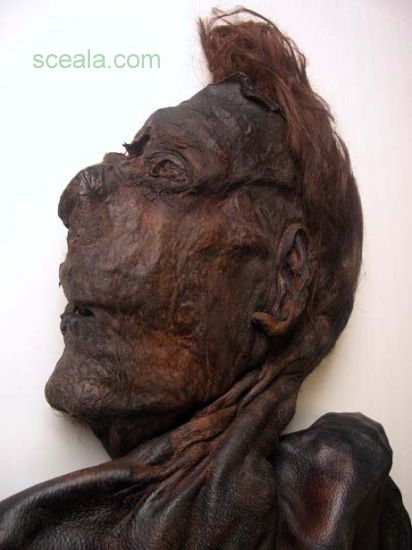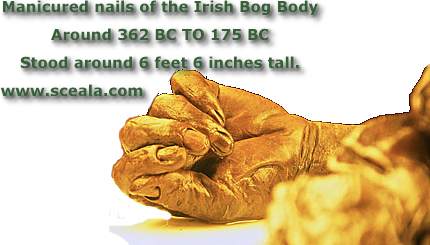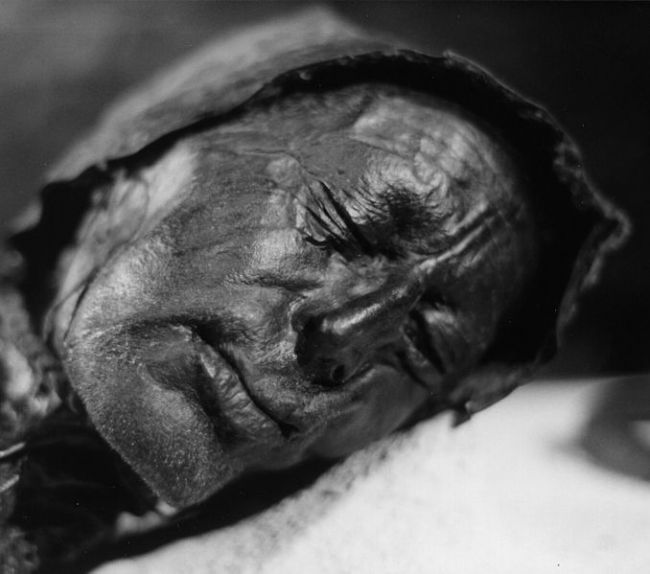| Irish Forums Message Discussion :: Irish Bog Body discovery from Prehistoric Ireland era |
   | Irish Forums :: The Irish Message
Forums About Ireland and the Irish Community, For the Irish home and Abroad. Forums include- Irish Music, Irish History, The Irish Diaspora, Irish Culture, Irish Sports, Astrology, Mystic, Irish Ancestry, Genealogy, Irish Travel, Irish Reunited and Craic
|  
|
Irish Bog Body discovery from Prehistoric Ireland era


|
|
|
| Irish
Author |
Irish Bog Body discovery from Prehistoric Ireland era Sceala Irish Craic Forum Irish Message |
|
Irish hal
Sceala Philosopher
Location: Carnew
|
| Sceala Irish Craic Forum Discussion:
Irish Bog Body discovery from Prehistoric Ireland era
|
|
|
A new Irish bog body has been discovered in a County Laois bog.
This is just so awesome to think about.
Irish Bog Body discovery from Prehistoric Ireland era
The remains, understood to be those of a young woman, were found by an employee of Bord Na Mona who was operating a milling machine in the Cul na Mona bog between Abbeyleix and Portlaoise last week.
Initial examinations of the prehistoric bog body suggest the woman may have been a human sacrifice in Ireland. Dated to between 2,000 and 3,000 years old.
There have been over 100 bog bodies discovered in Ireland
This latest discovery adds to the well preserved Irish bog bodies from prehistoric Ireland.
The Meenybradden Woman is an Irish Bog body discovered in 1978.
Clonycavan Man is the name given to a well-preserved Iron Age bog body found in Clonycavan, County Meath, Ireland in March 2003.

Clonycavan Man is the name given to a well-preserved Iron Age bog body found in Clonycavan, County Meath, Ireland in March 2003. This Irish bog body is remarkable for the "gel" in his hair.
Only his torso and upper abdomen are preserved. He was found in a peat harvesting machine, which was possibly responsible for the severing of his lower body. He had a squashed nose and crooked teeth. Pores are visible on the nose, and he had a thin beard.
Old Croghan Man is the name given to a well-preserved Iron Age bog body found in an Irish bog in June 2003. The remains are named after Croghan Hill, north of Daingean, County Offaly, near where the body was found.

This Irish bog body is the tallest prehistoric bog body ever found anywhere. He would have been considered a giant of a man in his time.
One of the Irish bog bodies on display in the National Museum of Ireland in Dublin.
Tumbeagh body Ireland dated1420-1630 AD discovered 1998
Gallagh Man was estimated to have died from 400-200 BCE. The man was discovered lying on his side 9 feet below the surface of an Irish bog in 1821.
Stoneyisland Man Ireland's oldest bog body
Stoneyisland Man, Bog body discovered in Stoneyisland Bog, Gortanumera, County Galway, 13 May 1929.
Turf-cutters James Dolphin, Thomas Rodgers and John Spain uncovered a human skeleton while working on Dolphin's bank, located towards the centre of Stoneyisland Bog. It was first thought to be the remains of a Mr. Ward of Ballyshrule who had been missing for some time, but it was later revealed to be over five thousand years old.
Some of the bog body discoveries are part of an exhibit in the National Museum of Ireland in Dublin - and featured in the exhibition "Kingship and Sacrifice", 2006-2007.
Latest bog body discovery in Ireland
The remains, understood to be those of a young woman, were found by an employee of Bord Na Móna who was operating a milling machine in the Cul na Móna bog between Abbeyleix and Portlaoise last week.
Initial examinations of the prehistoric bog body suggest the woman may have been a human sacrifice in Ireland. Dated to between 2,000 and 3,000 years old.
There have been over 100 bog bodies discovered in Ireland
According to Irish Peatland Conservation Council: “For thousands of years the bogs, through their extraordinary preservative qualities have kept ancient remains intact that would have otherwise perished on dry land; such as the bodies of unwary travellers trapped in the bog, or prehistoric track ways, and sometimes even whole villages and farms.”
Bogs can be treacherous places and it is likely that some of the bodies found in the peat were those of travellers who slipped into bog pools and were trapped. Some ancient bodies found in the peat were supposedly found clutching heather or sticks as if attempting to haul themselves out. Other bodies found in bogs are deliberate burials.
The first more fully documented account of discovery of a bog body was at a peat bog on Drumkeragh Mountain in County Down, Ireland, it was written up by Lady Moira, the wife of the local landowner
Gallagh Man was estimated to have died from 400-200 BCE. The man was discovered lying on his side 9 feet below the surface of an Irish bog in 1821. A cape was found around his neck, which was most likely used to strangle him. Two wooden pegs fastened him to the ground which the killers probably imagined prevented the victim from becoming a type of zombie. The body is on display in the National Museum of Ireland
The Meenybradden Woman is an Irish Bog body discovered in 1978 in Meenybradden Bog, Co. Donegal. The body of the young girl was discovered during hand turf cutting in Meenybradden Bog, near Ardara, Co. Donegal in 1978. The naked body was wrapped in a woollen cloak, of a style worn in the Middle Ages, which served as a shroud. The body had been carefully placed in a grave that had been dug in the bog about 1m below the surface. She was believed to be around 25–30 years old at her time of death. The Meenybradden woman's cloak has brought in a bit of controversy. The body was found out to be around 500 years older than the cloak that her remains were wrapped in. Her body was buried about one meter deep into the bog. She was examined by Dr. John Harbison. Her cloak has been dated by textile typology to 16th-17th century, a 14C-dating has not yet been performed on the garment.
This was the first time an opportunity arose to examine an Irish bog body in detail.
A body found in 1821 at Gallagh, near Castleblakeney, Co. Galway and was radiocarbon dated to 2,040 years old, indicating that it belonged to the Iron Age. The body of a man lay at a depth of 3m in the bog. It was not conserved at that time because the technology of freeze-drying which is used today had not been invented.
The National Museum of Ireland has two well preserved Prehistroic bog bodies on permanent display. The bodies were found at Oldcroghan, Co Offaly, and Clonycavan, Co Meath.
RTE reports about the Irish Bog Body discovery from Prehistoric Ireland era
Praise for Bord na Móna staff in bog body find discovery
Bord Na Mona and its staff have been praised for their quick thinking to prevent damage to a prehistoric bog body found in Co Laois.
Ned Kelly, keeper at the National Museum’s Irish antiquities division, said the prompt action, particularly of the milling machine driver who made the discovery, was very welcome.
“They all responded very, very quickly and acted absolutely correctly. What we’ve got is very exciting,” Mr Kelly said.
“This is reasonably well preserved and completely in situ, so we can get information we couldn’t get before.”
Mr Kelly said the body would initially have been buried at a considerable depth.
The body, which is estimated to be more than 2,000 years old, was found in a leather bag. It was discovered in the Cul na Móna Bog near Portlaoise.
Conditions including highly acidic water, low temperature and a lack of oxygen combine to preserve bog bodies. In the process skin is severely tanned, giving it a leathery appearance.
Mr Kelly attributed significance to the location of the body.
“We can’t tell if it is Iron Age, but it has been found on an ancient tribal boundary, a characteristic of other finds of Iron Age date,” he said.
He said burying bodies on tribal boundaries was “an observed practice” during the Iron Age and this body did seem to fit to that description, though it was too early to be certain.
The body would be removed to the National Museum as soon as possible, he said, and a study of where it had been found would be carried out.
A spokesman for Bord na Móna said they were very excited about the find and welcomed the further investigations that would take place.
“We have a protocol in place for such finds and we are very pleased that it worked well in this instance,” he said.
Staff from both Bord na Móna and the National Museum also examined a mound of peat recovered from the same area of the bog which could possibly contain other parts of the find.
The museum currently has two well-preserved bog bodies on permanent display in its archaeological branch in Kildare Street, Dublin.
Both bodies are from the Iron Age and were found at Oldcroghan, Co Offaly, and Clonycavan, Co Meath.

The Tollund Man is the naturally mummified corpse of a man who lived during the 4th century Prehistoric times, was found in 1950 buried in a peat bog on the Jutland Peninsula in Denmark, which preserved his body. The head and face of this bog body were so well-preserved that he was mistaken at the time of discovery for a recent murder victim.
Reports of the Irish Bog Body discovery from Prehistoric Ireland era
Images from earlier Irish Bog Body discovered from the Prehistoric era in Ireland.
The man is calculated (based on his arm span) to have stood 6 ft 6 in (1.98m) tall - tall for that time and the tallest bog body ever found. The man's apparently manicured nails led to speculation that he was not someone who engaged in manual labour, and possibly therefore of high status.
His last meal (analysed from the contents in his stomach) was believed to have been wheat and buttermilk. However, he was shown to have had a meat rich diet for at least the 4 months prior to this. Scars on his lungs suggest he may have suffered from pleurisy. At the time of his interment, he was naked except for a plaited leather band around his left hand. The man is believed to have died from a stab wound to the chest, been decapitated and had his body cut in half. This supposition is based on the lack of a head, and body below the hips. He also has a scar on his arm - possible evidence that he tried to defend himself. The body was found to have deep cuts under each nipple. Several theories have been suggested to explain this, including that the damage was caused (after death) by conditions in the bog, that the cuts were indicative of torture while the man was alive, or that the nipples were deliberately mutilated (either before or after death) for symbolic purposes. The latter theory, put forward by Eamonn Kelly of the National Museum of Ireland, suggests that the mutilation was a symbolic gesture to mark the man as a rejected ruler. Other theories suggest that Old Croghan Man and other bog bodies were sacrifices to gods of fertility or harvest, and killed and buried to ensure good yields of corn and milk.
Irish Bog Body discovery from Prehistoric Ireland era
Ancient Manuscript Found In Irish Bog
Irish bog bodies
ancient christian brooch found in peat fire ashes
More Pieces Of Ancient Irish Book Of Psalms Found In Bog
RTE Treasure Of The Bogs. Faddan More Psalter
Irish Bog Body discovery from Prehistoric Ireland era
|
|
|
|
|
|
|
|
|
|











